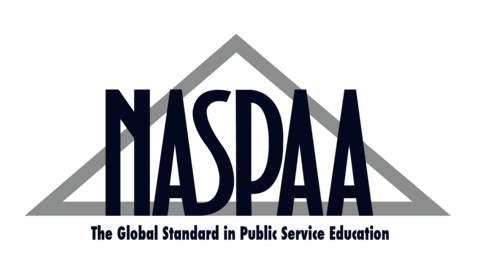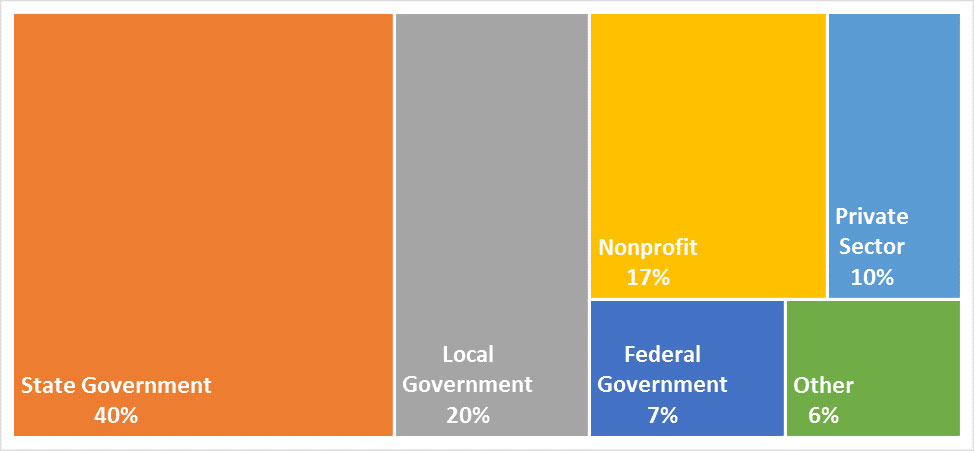Preparing the Next Generation of Public Service Professionals
Our MPA takes a practice-oriented, research-based approach to training those who want to serve the public good. We equip students with the core leadership, budgeting, management, and analysis skills to make an immediate impact.
Mission Statement
The Master of Public Administration (MPA) program strives to advance the public interest and civic engagement. We educate current and future governmental and nonprofit public service professionals through the innovative integration of disciplinary knowledge and skills with practice. Our location in the state capital provides access to a diverse networked community of public affairs scholars, practitioners, and students.
Student Learning Outcomes
- Lead and manage in public governance
- Communicate in a clear and concise manner
- Apply relevant theories, knowledge, and skills to effectively manage resources and programs
- Participate in and contribute to the public policy process
- Describe the public policy process and the role of the various participants and stakeholders
- Identify problems, frame the issues, and identify and evaluate alternatives for addressing a problem
- Analyze, synthesize, think critically, solve problems, and make decisions
- Demonstrate the ability to collect, analyze, and interpret data for use in decision making, and drawing conclusions
- Critically read and apply findings from studies and reports
- Articulate and apply a public service perspective
- Articulate the importance of and operate in a manner that facilitates democracy, equity, transparency, efficiency, and ethics
- Communicate and interact productively with a diverse and changing workforce and citizenry
- Demonstrate a sensitivity of and respect for differences in culture
Accreditation Data

The UIS School of Public Management and Policy's Master of Public Administration (MPA) program currently serves about 180 students and is accredited by the Network of Schools of Public Policy, Affairs, and Administration (NASPAA).
Student Cohort Degree Completion Outcomes
| Cohort Academic Year | Initially Enrolled | Graduated w/In 2 Years | Graduated W/in 3 Years | Graduated W/in 4 Years | Total Graduating & Persisting to Graduation |
|---|---|---|---|---|---|
| 2018-2019 | 71 | 41 | 49 | 51 | 59 |
| 2017-2018 | 98 | 54 | 62 | 64 | 65 |
| 2016-2017 | 105 | 50 | 62 | 67 | 76 |
| 2015-16 | 68 | 29 | 43 | 46 | 51 |
| 2014-15 | 92 | 54 | 62 | 67 | 69 |
| 2013-14 | 104 | 25 | 60 | 72 | 81 |
| 2012-13 | 119 | 65 | 83 | 87 | 119 |
| 2011-12 | 119 | 78 | 92 | 96 | 119 |
Employers, Recent MPA Graduates
We are proud of the public service contributions our graduates are making.
- President, Woods Fund of Chicago
- Manager at University of Illinois Foundation
- JOPES Analyst at USARCENT, 3rd Army
- Student - Naval War College
- Teach for America, Corps Member
- Director, Habitat for Humanity Chapter
- Procurement Compliance Monitor at Executive Ethics Commission
- Wind Energy Program Coordinator at Illinois Institute for Rural Affairs at Western Illinois University
- Director, Municipal Housing Authority
- Health Initiatives Representative at American Cancer Society
- National Parks Conservation Association - Center for Park Management Program Coordinator
- Supervisor, Planning, Research & Development at Illinois Department on Aging
- Village of Chapin Village President, Crisis Management Director
- Programme Associate, United Nations
- Research Manager, Greater Springfield Chamber of Commerce and Quantum Growth Partnership
- Staff Assistant to Dept. Director of Highways
- Supervisory Adjudications Officer for U.S. Citizenship & Immigration Services (USCIS)
- Acting Warden, Correction Center
- Public Works Director
- Budget Tech, Corps of Engineers
- Assistant Agricultural Commissioner and Sealer
- Military Police Team Leader, Army National Guard
- Operations Budget Analyst, Governor's Office of Management and Budget

MPA career outcomes by sector: State Government 40 percent, Local Government 20 percent, Nonprofit 17 percent, Federal Government 7 percent, Private Sector 10 percent, and Other 6 percent
Employment Data
MPA career outcomes by employment sector, with 100% of reporting graduates employed or pursuing additional education.
Employment by NASPAA Categories
| Employment Categories | 2015-16 Graduates | 2016-17 Graduates | 2017-18 Graduates | 2018-19 Graduates | 2019-20 Graduates | 2020-21 Graduates | 2021-22 Graduates | 2022-23 GRADUATES |
|---|---|---|---|---|---|---|---|---|
| National or central government in the same country as the program | 4 | 6 | 0 | 3 | 5 | 2 | 0 | 0 |
| State, provincial or regional government in the same country as the program | 21 | 27 | 20 | 24 | 20 | 22 | 21 | 19 |
| City, county or other local government in the same country as the program | 11 | 7 | 15 | 14 | 18 | 15 | 12 | 8 |
| Foreign government (all levels) or international quasi-governmental | 0 | 1 | 0 | 1 | 0 | 0 | 0 | 1 |
| Nonprofit domestic-oriented | 13 | 9 | 3 | 9 | 6 | 4 | 4 | 7 |
| Nonprofit/NGOs internationally-oriented | 0 | 0 | 0 | 0 | 0 | 0 | 0 | 0 |
| Private Sector - research/consulting | 0 | 0 | 0 | 1 | 1 | 0 | 1 | 1 |
| Private Sector (not research/consulting) | 12 | 4 | 2 | 9 | 4 | 5 | 3 | 5 |
| Military | 5 | 0 | 1 | 4 | 0 | 2 | 6 | 1 |
| Obtaining further education | 1 | 1 | 1 | 1 | 1 | 0 | 0 | 0 |
| Unemployed seeking employment | 0 | 0 | 0 | 0 | 0 | 0 | 0 | 0 |
| Unemployed not seeking employment | 0 | 0 | 0 | 0 | 0 | 0 | 0 | 0 |
| Status Unknown | 3 | 3 | 6 | 5 | 2 | 2 | 0 | 1 |
| Total Number of Graduates | 70 | 58 | 48 | 71 | 57 | 52 | 47 | 43 |
